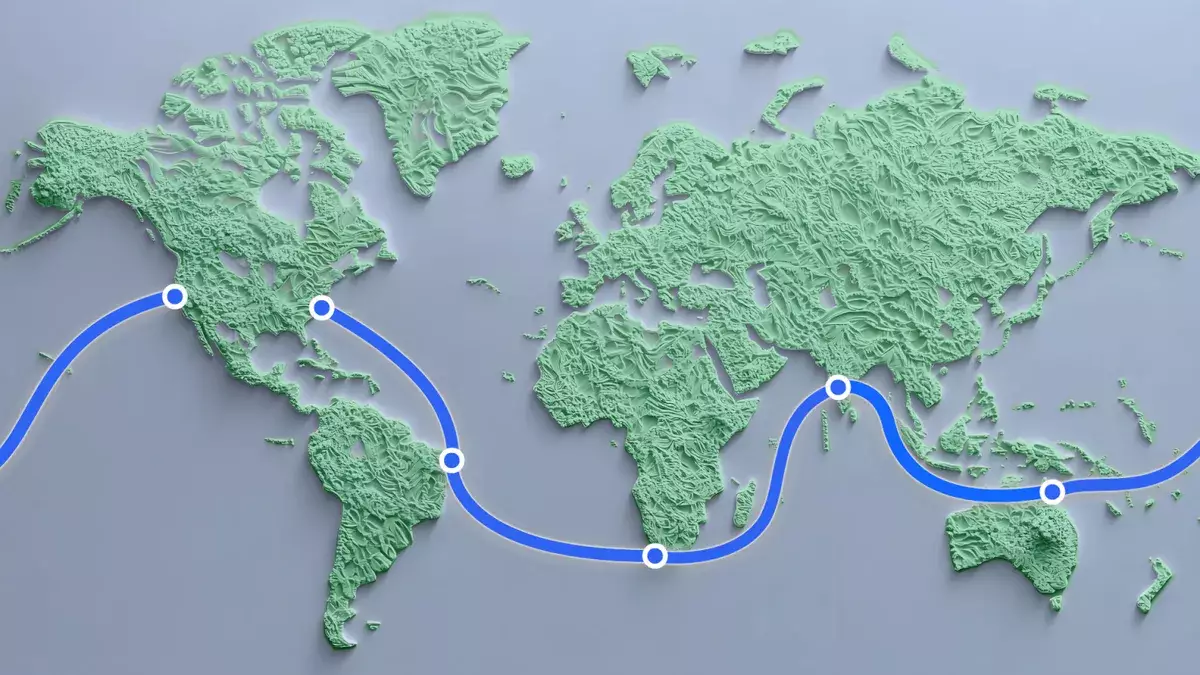In our increasingly interconnected world of 2025, the notion of wireless communication dominates the narrative of modern tech infrastructure. Wireless technology offers unparalleled convenience and seemingly unbounded access to information. However, this perception can obscure an essential truth: a vast network of physical cables serves as the backbone of global digital communication, carrying approximately 98% of all internet traffic. The announcement of Meta’s ambitious Project Waterworth—a monumental undersea cable plan—serves as a poignant reminder of the complexities and physical realities that underpin our wireless fantasies.
Project Waterworth aims to be the longest undersea cable in history, extending over 31,000 miles (approximately 50,000 kilometers) and designed to delve as deep as four miles beneath the ocean’s surface. This massive infrastructure initiative will expand connectivity across critical regions, including the United States, India, South Africa, and Brazil, significantly enhancing the digital infrastructure between continents. Rather than providing a direct link, the cable will weave around the globe, starting on the U.S. eastern seaboard, traversing the Atlantic, rounding Africa, and making its way to Australia before circling back to California.
This intricate routing showcases not just necessary connectivity but also the challenges inherent in marine construction. Meta’s commitment to deploying cutting-edge technologies for cable resilience and safety is particularly noteworthy. By leveraging advanced burial techniques, the initiative aims to protect against hazards like ship anchors and geological faults, ensuring that this vital infrastructure can withstand the test of time and tumultuous ocean conditions.
The impact of Project Waterworth transcends mere connectivity; it stands to fortify the digital economy as a whole. Described as a “multi-billion dollar, multi-year investment,” the cable is anticipated to unlock three new oceanic corridors, facilitating high-speed data transfer essential for various applications, notably artificial intelligence (AI) advancements. As AI continues to proliferate across industries—from healthcare to finance—reliable and swift internet connectivity becomes a prerequisite for innovation and development.
By enhancing global digital networks, Meta’s initiative could invigorate regional economies, providing businesses with the tools to harness AI capabilities effectively. In a landscape where every millisecond counts, reducing latency and increasing bandwidth could pave the way for unprecedented advancements, professional collaborations across borders, and even new market opportunities.
Despite the technical grandeur of Project Waterworth, Meta’s public relations have faced scrutiny and controversy in recent years. CEO Mark Zuckerberg’s decisions to alter fact-checking protocols on social media platforms reflect a broader concern regarding the societal consequences of unbridled digital communication. While the decision to favor “community notes” over traditional fact-checkers may have been born from a desire to combat perceived bias, it raises questions about the responsibility of tech giants in moderating the content they host.
Nonetheless, the unveiling of Project Waterworth provides a tangible counterpoint to the abstract controversies surrounding social media. It highlights Meta’s potential role in fostering essential global infrastructure, directing attention away from the controversies that often shroud the company’s activities. In doing so, it reminds us that behind the screens of partisan debate, a different kind of progress is at play—one that sustains economies and connects societies in profound ways.
Ultimately, the juxtaposition of Meta’s undersea cable project with its tumultuous public image underscores a critical lesson about the nature of progress in today’s world. The dichotomy between the aspiration for a connected, wireless future and the physical and logistical realities of that connectivity is striking. As we propel forward into an ever-evolving digital landscape, initiatives like Project Waterworth will be instrumental in shaping the contours of that future—offering hope that, despite the complexities of industry reputation and social discourse, there continues to be substantial investment in the very foundation of our global communications network. Balancing these dimensions will be essential as humanity navigates the intricate dance between innovation and accountability.

